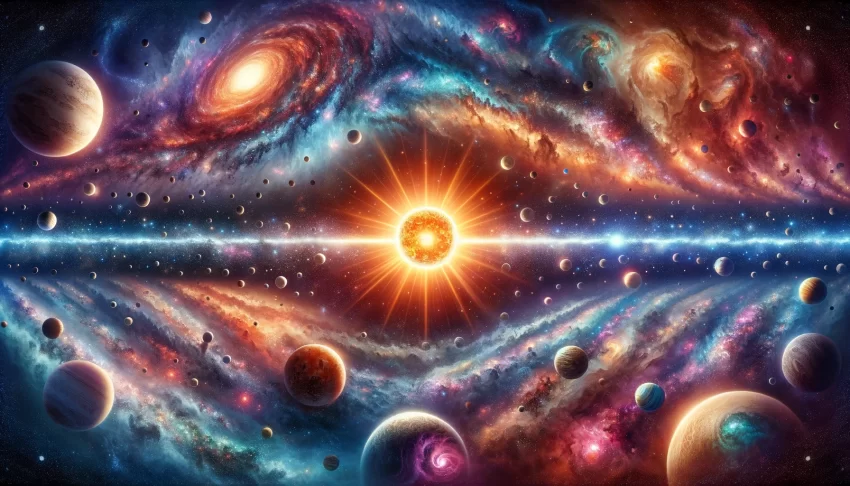| Listen to our audio presentation: The James Webb Space Telescope |
Researchers from the Massachusetts Institute of Technology (MIT), including undergraduates, have achieved a remarkable breakthrough: discovering some of the oldest stars in the universe right in our galactic neighborhood. This exciting finding unfolds new avenues for understanding the birth and evolution of the cosmos.
Unearthing Stellar Antiquities
MIT researchers, spearheaded by physics professor Anna Frebel, have identified three ancient stars located in the “halo” of the Milky Way. The halo is the cloud of stars wrapping around the main galactic disk. Their analysis suggests that these stars, formed 12 to 13 billion years ago, are among the universe’s earliest inhabitants, dating back to the period when the first galaxies were emerging.
What are SASS Stars?
The researchers have named these ancient stars “Small Accreted Stellar System” (SASS) stars. According to Professor Frebel, each of these stars likely belonged to small and primitive galaxies that were later integrated into the expanding Milky Way. All that remains now of their original galaxies are these three stars, lingering on the galaxy’s fringes. Frebel emphasizes the significance of these ancient stars: “These oldest stars should definitely be there, given what we know of galaxy formation. They are part of our cosmic family tree. And we now have a new way to find them.”
Frebel hopes that identifying more SASS stars could enlighten us about ultrafaint dwarf galaxies—some of the first galaxies still intact today but too far away and dim to be deeply explored. SASS stars, much closer and brighter, could act as analogs for these galaxies, offering insights into their chemical evolution.
Classroom to Cosmos
The genesis of this discovery traces back to an educational setting. In the fall of 2022, Frebel introduced a course titled “Observational Stellar Archaeology” at MIT, allowing students to analyze and determine the origins of ancient stars. This hands-on course quickly positioned students at the forefront of astrophysical research.
By sifting through a binder of star data collected over the years by the 6.5-meter Magellan-Clay Telescope at the Las Campanas Observatory, the students zeroed in on three stars with spectral properties indicative of ancient origins. Their chemical composition, particularly low levels of elements like strontium and barium, matched characteristics identified in other ancient stars and galaxies.
Hillary Andales, a co-author of the study, recollects the experience: “While most of our classes are taught from the ground up, this class immediately put us at the frontier of research in astrophysics.”
The Orbital Puzzle
The team took an unexpected route to underpin their findings by examining the orbital behaviors of these stars. Situated about 30,000 light-years from Earth, these stars exhibited “retrograde motion,” moving contrary to the majority of stars in the galactic disk, indicating that they were drawn in from another place.
Frebel explains this phenomenon: “The only way you can have stars going the wrong way from the rest of the gang is if you threw them in the wrong way.” This retrograde motion, coupled with their low chemical abundance, strongly suggests that these stars originated from older, smaller galaxies that merged into the Milky Way billions of years ago.
Upon checking the scientific literature, the team identified 65 other stars with low strontium and barium abundances also showing retrograde motion. “Interestingly, they’re all quite fast—hundreds of kilometers per second, going the wrong way,” Frebel remarks. “They’re on the run! We don’t know why that’s the case, but it was the piece to the puzzle that we needed, and that I didn’t quite anticipate when we started.”
A Glimpse into the Deep Past
As the team continues their hunt for SASS stars using the established methods, their discoveries could progressively enhance our understanding of the Milky Way’s formation and the primordial universe. Frebel looks forward to running the course again and is proud of the trailblazing work her students have accomplished.
“It’s been awesome to work with three women undergrads. That’s a first for me,” she shares. “It’s really an example of the MIT way. We do. And whoever says, ‘I want to participate,’ they can do that, and good things happen.”
Information Box
What are SASS Stars?
– Small Accreted Stellar System (SASS) stars: Ancient stars believed to have belonged to primitive galaxies later absorbed by the Milky Way.
Quick Facts:
– Discovery: Spotted in the Milky Way’s halo.
– Age: Formed 12 to 13 billion years ago.
– Distance: Approximately 30,000 light-years from Earth.
– Chemical Composition: Low abundances of elements like strontium, barium, and iron.
Research Methods:
– Techniques: Spectral analysis to determine chemical composition.
– Tools: Data from the 6.5-meter Magellan-Clay Telescope at Las Campanas Observatory.
– Identification: Retrograde orbital motion checked via Gaia astrometric satellite.
Additional Insights
Methuselah Star:
– Previously believed to be the oldest star in the universe at around 14.3 billion years (HD140283), but its age is still a topic of ongoing research.
NASA’s Role:
– Observatories like COBE and WMAP have explored remnants of the Big Bang, aiding in our understanding of early cosmic structures.
– Webb telescope is designed to help find and analyze the universe’s first stars and galaxies, shifting our view towards the infrared spectrum.
References
– Reference 1: Jennifer Chu, MIT News, “MIT researchers discover the universe’s oldest stars in our own galactic backyard,” May 14, 2024.
– Reference 2: David Crookes, Space.com, “Methuselah: The oldest star in the universe,” March 7, 2022.
– Reference 3: NASA, “Early Universe” webpage.

